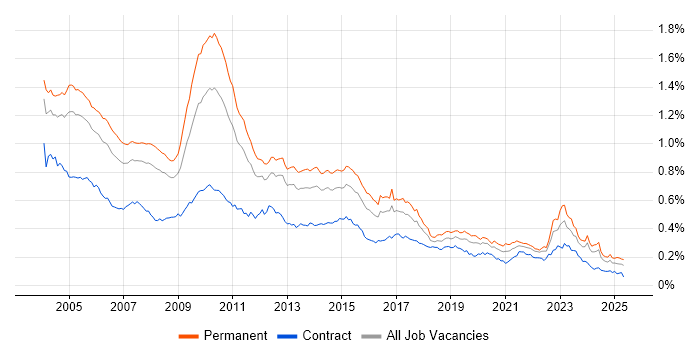Client Server
UK
The table below looks at the prevalence of the term Client/Server in permanent job vacancies. Included is a benchmarking guide to the salaries offered in vacancies that cited Client/Server over the 6 months leading up to 30 May 2025, comparing them to the same period in the previous two years.
| 6 months to 30 May 2025 |
Same period 2024 | Same period 2023 | |
|---|---|---|---|
| Rank | 616 | 466 | 446 |
| Rank change year-on-year | -150 | -20 | +375 |
| Permanent jobs citing Client/Server | 93 | 508 | 678 |
| As % of all permanent jobs advertised in the UK | 0.17% | 0.49% | 0.70% |
| As % of the Miscellaneous category | 0.45% | 1.43% | 1.60% |
| Number of salaries quoted | 68 | 454 | 574 |
| 10th Percentile | £25,500 | £36,475 | £39,575 |
| 25th Percentile | £32,611 | £52,500 | £52,500 |
| Median annual salary (50th Percentile) | £52,250 | £74,500 | £75,000 |
| Median % change year-on-year | -29.87% | -0.67% | +31.58% |
| 75th Percentile | £63,500 | £91,250 | £96,250 |
| 90th Percentile | £79,875 | £112,500 | £112,500 |
| UK excluding London median annual salary | £52,000 | £60,000 | £65,000 |
| % change year-on-year | -13.33% | -7.69% | +30.00% |
All Generic Skills
UK
Client/Server falls under the General and Transferable Skills category. For comparison with the information above, the following table provides summary statistics for all permanent job vacancies requiring generic IT skills.
| Permanent vacancies with a requirement for generic IT skills | 20,604 | 35,638 | 42,318 |
| As % of all permanent jobs advertised in the UK | 37.19% | 34.51% | 43.55% |
| Number of salaries quoted | 9,493 | 23,121 | 22,633 |
| 10th Percentile | £31,250 | £28,000 | £35,750 |
| 25th Percentile | £42,000 | £38,084 | £46,350 |
| Median annual salary (50th Percentile) | £60,000 | £55,000 | £65,000 |
| Median % change year-on-year | +9.09% | -15.38% | +4.00% |
| 75th Percentile | £78,750 | £75,000 | £86,250 |
| 90th Percentile | £110,000 | £97,500 | £110,000 |
| UK excluding London median annual salary | £55,000 | £50,000 | £55,000 |
| % change year-on-year | +10.00% | -9.09% | +4.76% |
Client/Server
Job Vacancy Trend
Job postings citing Client/Server as a proportion of all IT jobs advertised.

Client/Server
Salary Trend
3-month moving average salary quoted in jobs citing Client/Server.
Client/Server
Salary Histogram
Salary distribution for jobs citing Client/Server over the 6 months to 30 May 2025.
Client/Server
Top 13 Job Locations
The table below looks at the demand and provides a guide to the median salaries quoted in IT jobs citing Client/Server within the UK over the 6 months to 30 May 2025. The 'Rank Change' column provides an indication of the change in demand within each location based on the same 6 month period last year.
| Location | Rank Change on Same Period Last Year |
Matching Permanent IT Job Ads |
Median Salary Past 6 Months |
Median Salary % Change on Same Period Last Year |
Live Jobs |
|---|---|---|---|---|---|
| England | -174 | 89 | £52,250 | -30.33% | 376 |
| UK excluding London | +8 | 66 | £52,000 | -13.33% | 313 |
| South East | +49 | 32 | £33,750 | -35.71% | 126 |
| Work from Home | -156 | 29 | £55,750 | -25.67% | 334 |
| London | -82 | 22 | £55,000 | -35.29% | 116 |
| East of England | -12 | 14 | £62,000 | -11.43% | 54 |
| North of England | -4 | 13 | £55,750 | -14.23% | 79 |
| North West | +4 | 7 | £50,000 | -9.09% | 47 |
| South West | +90 | 6 | £77,500 | +63.16% | 17 |
| Yorkshire | +50 | 3 | £37,500 | +25.00% | 11 |
| North East | +6 | 3 | £115,000 | +60.84% | 26 |
| Midlands | +66 | 1 | £60,000 | +16.50% | 36 |
| East Midlands | +41 | 1 | £60,000 | -3.23% | 17 |
Client/Server
Co-occurring Skills and Capabilities by Category
The follow tables expand on the table above by listing co-occurrences grouped by category. The same employment type, locality and period is covered with up to 20 co-occurrences shown in each of the following categories:
|
|
||||||||||||||||||||||||||||||||||||||||||||||||||||||||||||||||||||||||||||||||||||||||||||||||||||||||||||||||||||||||||||||
|
|
||||||||||||||||||||||||||||||||||||||||||||||||||||||||||||||||||||||||||||||||||||||||||||||||||||||||||||||||||||||||||||||
|
|
||||||||||||||||||||||||||||||||||||||||||||||||||||||||||||||||||||||||||||||||||||||||||||||||||||||||||||||||||||||||||||||
|
|
||||||||||||||||||||||||||||||||||||||||||||||||||||||||||||||||||||||||||||||||||||||||||||||||||||||||||||||||||||||||||||||
|
|
||||||||||||||||||||||||||||||||||||||||||||||||||||||||||||||||||||||||||||||||||||||||||||||||||||||||||||||||||||||||||||||
|
|
||||||||||||||||||||||||||||||||||||||||||||||||||||||||||||||||||||||||||||||||||||||||||||||||||||||||||||||||||||||||||||||
|
|
||||||||||||||||||||||||||||||||||||||||||||||||||||||||||||||||||||||||||||||||||||||||||||||||||||||||||||||||||||||||||||||
|
|
||||||||||||||||||||||||||||||||||||||||||||||||||||||||||||||||||||||||||||||||||||||||||||||||||||||||||||||||||||||||||||||
|
|
||||||||||||||||||||||||||||||||||||||||||||||||||||||||||||||||||||||||||||||||||||||||||||||||||||||||||||||||||||||||||||||
|
|||||||||||||||||||||||||||||||||||||||||||||||||||||||||||||||||||||||||||||||||||||||||||||||||||||||||||||||||||||||||||||||
